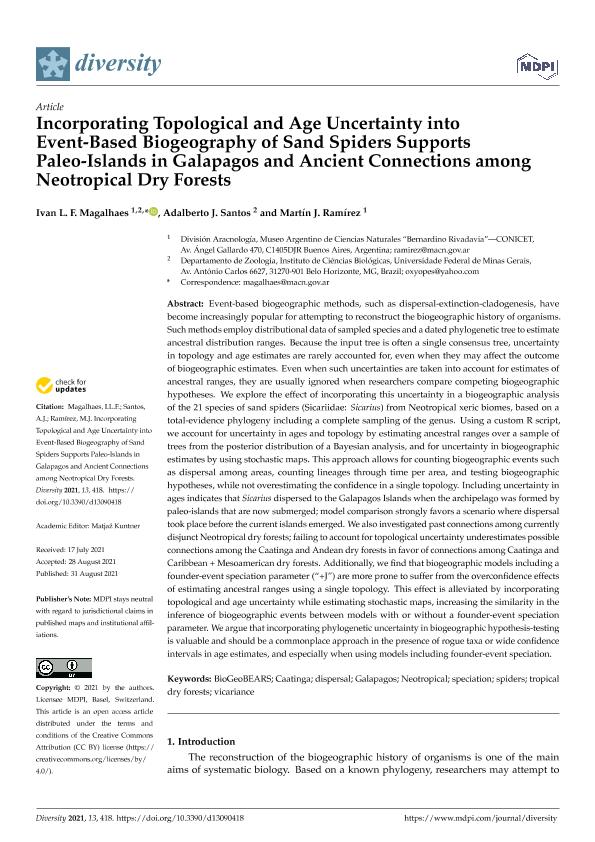Mostrar el registro sencillo del ítem
dc.contributor.author
Fiorini de Magalhaes, Ivan Luiz

dc.contributor.author
Santos, Adalberto J.
dc.contributor.author
Ramirez, Martin Javier

dc.date.available
2022-03-10T12:39:33Z
dc.date.issued
2021-08
dc.identifier.citation
Fiorini de Magalhaes, Ivan Luiz; Santos, Adalberto J.; Ramirez, Martin Javier; Incorporating topological and age uncertainty into event-based biogeography of sand spiders supports paleo-islands in galapagos and ancient connections among neotropical dry forests; MDPI; Diversity; 13; 9; 8-2021; 1-23
dc.identifier.issn
1424-2818
dc.identifier.uri
http://hdl.handle.net/11336/153163
dc.description.abstract
Event-based biogeographic methods, such as dispersal-extinction-cladogenesis, have become increasingly popular for attempting to reconstruct the biogeographic history of organisms. Such methods employ distributional data of sampled species and a dated phylogenetic tree to estimate ancestral distribution ranges. Because the input tree is often a single consensus tree, uncertainty in topology and age estimates are rarely accounted for, even when they may affect the outcome of biogeographic estimates. Even when such uncertainties are taken into account for estimates of ancestral ranges, they are usually ignored when researchers compare competing biogeographic hypotheses. We explore the effect of incorporating this uncertainty in a biogeographic analysis of the 21 species of sand spiders (Sicariidae: Sicarius) from Neotropical xeric biomes, based on a total-evidence phylogeny including a complete sampling of the genus. Using a custom R script, we account for uncertainty in ages and topology by estimating ancestral ranges over a sample of trees from the posterior distribution of a Bayesian analysis, and for uncertainty in biogeographic estimates by using stochastic maps. This approach allows for counting biogeographic events such as dispersal among areas, counting lineages through time per area, and testing biogeographic hypotheses, while not overestimating the confidence in a single topology. Including uncertainty in ages indicates that Sicarius dispersed to the Galapagos Islands when the archipelago was formed by paleo-islands that are now submerged; model comparison strongly favors a scenario where dispersal took place before the current islands emerged. We also investigated past connections among currently disjunct Neotropical dry forests; failing to account for topological uncertainty underestimates possible connections among the Caatinga and Andean dry forests in favor of connections among Caatinga and Caribbean + Mesoamerican dry forests. Additionally, we find that biogeographic models including a founder-event speciation parameter (“+J”) are more prone to suffer from the overconfidence effects of estimating ancestral ranges using a single topology. This effect is alleviated by incorporating topological and age uncertainty while estimating stochastic maps, increasing the similarity in the inference of biogeographic events between models with or without a founder-event speciation parameter. We argue that incorporating phylogenetic uncertainty in biogeographic hypothesis-testing is valuable and should be a commonplace approach in the presence of rogue taxa or wide confidence intervals in age estimates, and especially when using models including founder-event speciation.
dc.format
application/pdf
dc.language.iso
eng
dc.publisher
MDPI
dc.rights
info:eu-repo/semantics/openAccess
dc.rights.uri
https://creativecommons.org/licenses/by/2.5/ar/
dc.subject
BIOGEOBEARS
dc.subject
CAATINGA
dc.subject
DISPERSAL
dc.subject
GALAPAGOS
dc.subject
NEOTROPICAL
dc.subject
SPECIATION
dc.subject
SPIDERS
dc.subject
TROPICAL DRY FORESTS
dc.subject
VICARIANCE
dc.subject.classification
Biología

dc.subject.classification
Ciencias Biológicas

dc.subject.classification
CIENCIAS NATURALES Y EXACTAS

dc.title
Incorporating topological and age uncertainty into event-based biogeography of sand spiders supports paleo-islands in galapagos and ancient connections among neotropical dry forests
dc.type
info:eu-repo/semantics/article
dc.type
info:ar-repo/semantics/artículo
dc.type
info:eu-repo/semantics/publishedVersion
dc.date.updated
2022-03-02T15:49:11Z
dc.journal.volume
13
dc.journal.number
9
dc.journal.pagination
1-23
dc.journal.pais
Suiza

dc.journal.ciudad
Basilea
dc.description.fil
Fil: Fiorini de Magalhaes, Ivan Luiz. Universidade Federal de Minas Gerais; Brasil. Consejo Nacional de Investigaciones Científicas y Técnicas. Oficina de Coordinación Administrativa Parque Centenario. Museo Argentino de Ciencias Naturales "Bernardino Rivadavia"; Argentina
dc.description.fil
Fil: Santos, Adalberto J.. Universidade Federal de Minas Gerais; Brasil
dc.description.fil
Fil: Ramirez, Martin Javier. Consejo Nacional de Investigaciones Científicas y Técnicas. Oficina de Coordinación Administrativa Parque Centenario. Museo Argentino de Ciencias Naturales "Bernardino Rivadavia"; Argentina
dc.journal.title
Diversity
dc.relation.alternativeid
info:eu-repo/semantics/altIdentifier/doi/http://dx.doi.org/10.3390/d13090418
dc.relation.alternativeid
info:eu-repo/semantics/altIdentifier/url/https://www.mdpi.com/1424-2818/13/9/418
Archivos asociados
